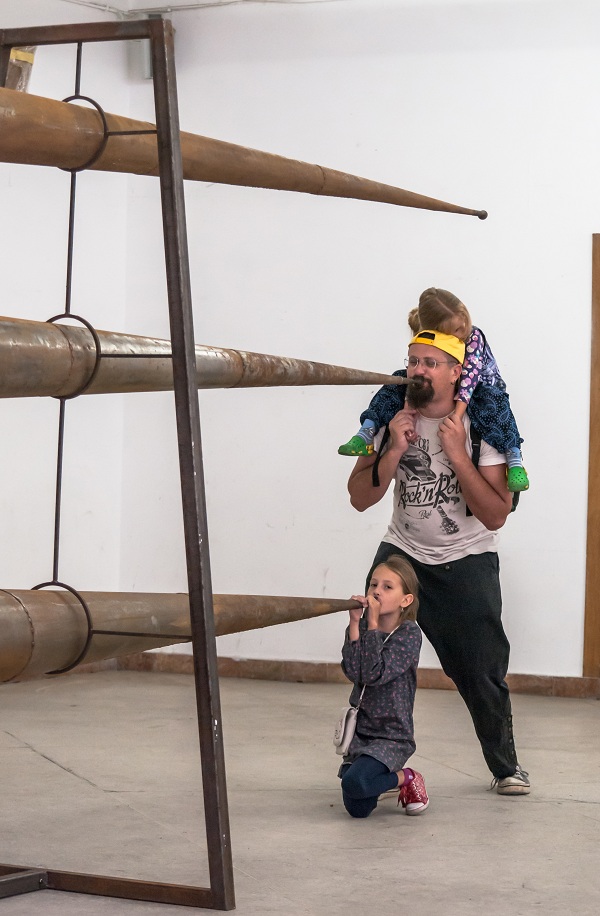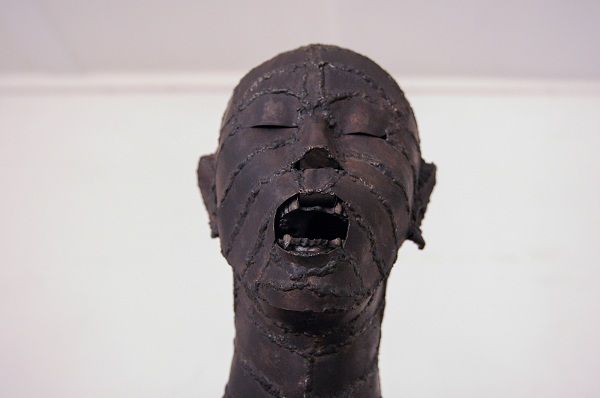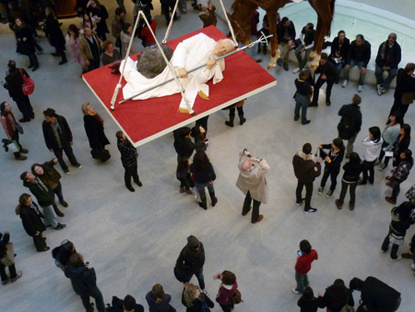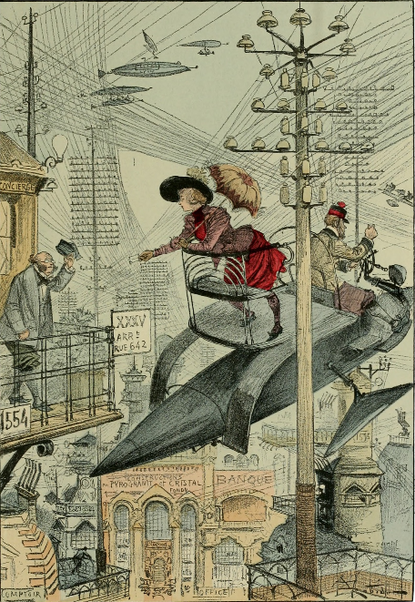“Folks” at the Lviv Art Palace
While the majority gets its fill of breaking news coming from the warzone in the east and TV soccer, developments in the arts garner the interest of a relatively tiny circle of devotees. In the anxious heat of the Summer of 2014, OlexaFurdiyak & Co. have opened a new exhibit entitled “Folks” (Ukr. – liud) at the Lviv Art Palace. Notwithstanding the upcoming program in this Fall’s Week of Contemporary Art, the Folks exhibit makes a case for arts event of the year in the city.
So what makes this event so significant?
Even in the city of Lviv, with its esteemed school, long honored tradition, and current pop-trendiness of sidewalk sculpture, it is a rare occurrence when a sculptor and artist puts his achievements in form on display in such a personal, nearly retrospective, exhibit. Despite the three names listed on the posters (Oleh Voronko should have been a fourth), it is proper to talk about this event as a solo show of Olexa Furdiyak. Yet, in keeping with the current particularity of an artist turning to colleagues for help of a technical nature in a given project, with Folks, Yuri Yaremchuk has contributed the sound, Ihor Slobodyan the welding, and Oleh Voronko the video effects.
Aesthetic expression as well as age place Furdiyak in the generation of artists between Mykola Malyshko and Zhanna Kadyrova, thus studiously avoiding both the archaic as well as ever-juvenile pop-art destructive absurdism. It’s the idea – the ideology – that is preeminent with this artist; ‘subject’, ‘object’, and ‘sculpture’ serve merely as the means of its expression. Fittingly, the exhibit provides sufficient explanatory material (see the artist’s writing at artmedium.com.ua).
“Folks is a compilation of earlier collaborations which we were aiming to incorporate organically into the DUDINNYA performance installation, and which in time helped further crystallize the idea, and as a result the development of a new, fluid, thematic linearity and the ViborYASCHYK Project”, (from the artist’s notes on the exhibit).

In the first hall we are greeted by the concrete “Armstrong on the Moon”, (2010), the figure practically floating, supported by two cones. So which Armstrong are we talking about – the astronaut accused of shooting moonwalks on a film stage, or the jazz trumpeter? The piece’s rough surface evokes changes taking place at a deeper level. Its coarse stone texture recalls gravitational force and the power of art, which in a ready metaphor uncovers beauty in a place where one would not expect it.

Moving into the next hall we encounter a pair of metal hogs, painted black, standing on mesh metallic carpets. A neat opening is cut into the head of each animal, transforming them into the appropriately titled “Piggy Banks (ElectroSviny)”, (2009), the double title suggesting itself during production. Initially exhibited in a darkened room of the Museum, the sculpture was plugged into a wall socket and surrounded by barbed wire, separating it from observers. The artist’s intent was for the occasional striking, yet alarming, electrical arc to flit between the figures – lightning, in a word. “The title of this project has a double meaning, both of which lean on the other – in the pursuit of greater control you increase the pressure on yourself, and the internally active social compulsions which put you at risk for implosion, and of becoming a client of swinish consumption”, says the artist. And although the sculpture is painted black, it’s fitting to mention its pictorial quality – the color conveying emotion, distorting the surface, even concealing its materiality.
The exhibit draws on a classical spirit. Sculptures placed toward the center of large halls. Simple and elegant, sumptuously large, unforced and unapologetic. The exhibit lacks a unifying concept and its naming is arbitrary, with works that resist discrete denomination, any emphasis stemming from each piece’s sufficiency unto itself. A gorgeous silence permeates the arrangement. Yet this is not from a mere absence of sound, but the presence of a transcendental spirit. Strung-together objects frozen in space. Resisting all narrative with its own silent mode of expression. Yet it’s a deceptive silence which masks the grinding screech of sheet metal, the crash and thud of hammers, the hiss of the acetylene torch, clouds of dust and particles, and withering heat.

DUDDINYA (Eng., “horn blowing”) is a large, engaging installation dealing with sound, the weightlessness of air, and the complex simplicity of blowing through heavy, lightly corroded, and cleverly arranged horns. (The horns that brought down Jericho?) This sound proves something of a relic for the common folks, but are thy listening? It is incumbent upon us to strive to bring down walls of indifference and outright hypocrisy. Anyone who desires, regardless of his level of musical training, can take part in a piece of living art and harness the wind. The irony of the piece heightens the narrative sense incorporated in it.

The next grouping of “metal folks” is comprised of three, self-contained pieces – “Armstrong 2”, “Mother of Exiles (Baba)”, and “Ryhachiv”.
These life-sized sculptures by Olexa Furdiyak impress with their exquisitely detailed realism and plasticity, so expertly realized that they do not draw attention to their manufacture: the precise way in which the artist has captured the motion of the “Rychahiv” figures’ coats, or depicted the monumental, pleading “Mother”, or the tragic crippling of “Armstrong” leaning on his canes. Everything so seemingly clear-cut and coherent. Except that each sculpture incorporates some absurd detail – a long flow of silken white hair, or real crutches – the soft texture of the hair contrasting starkly with that of the rigid metal surface of the sculpture and the woven scarring of the welder’s torch.
Then the monumental and unperturbed silence is suddenly shattered by a subtle vibration along the length of one work. Rusty metal or black paint contrasts materially with the lustrous smoothness of the brushed, artificial white hair.
The arts molds and shapes objects from metal, though not with a cast but a welder’s torch. The coldness of the metal repelling, and preventing any close approach, and any touch shocks with the roughness of the material.

We should also mention the video project – “FOLKS (Relics of Sound)” – produced this year, 5’ 02” in length, which manifests in drastic and dissonant contrast to the static and eloquent silence of the sculptures (with the exception of DUDINNYA which sounds whenever a viewer puts lips to the exhibit). The incomprehensibility and inscrutability of this thing we call existence is underscored in black and white repeating images of a flickering Dyadya Mokh (known in musical circles) mashed up with obsessively absurd TV white noise. “He forms striking objects surging with waves from the primal deep. Images float to the surface you barely recognize before you lose them in that glimmer of reality and the endless rail line that fills you with hope in inviolate forms,and of perfect pith which allows you to enter into a state of trusting contemplation but no further…”, is what one of the authors has messily scratched on the wall nearby. And it’s difficult to disagree. What remains is to determine whose side you’re on.
These rhetorical figures employed by the artist point us back to the mythologies of modernism, to modes of existence of language and its limits, and to imagery which feeds on reality. Thus the artist, not content with mere volume of expression, gives significant attention to the exhibit narrative and experiments with video.
The exhibit pleases with the gravity of its worked material and the expressivity of the artist’s viewpoint. But will it provoke dialogue, debate, and discussion among us, or merely extend the apparent militant silence of, the language of suspect and fragile truce?
Photography: Yuri Bakay










